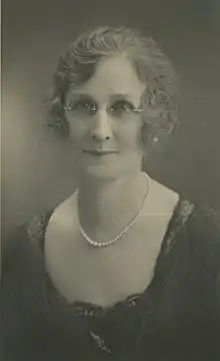Violet Targuse
Violet Targuse (née Healey, 1884 – 1937) was an early female playwright in New Zealand.[1][2][3] She has been described as "probably New Zealand's most successful and least acclaimed one-act playwright,"[4] and "the most successful writer in the early years" of the New Zealand branch of the British Drama League.[5] Active during the 1930s when her plays were widely performed by Women's Institute drama groups, they focused on women, especially the experiences and concerns of rural women in New Zealand.[6][7][8] Set in locations such as a freezing works, a sheep station, a shack on a railway siding, and a coastal lighthouse, her plays were seen as essentially New Zealand in setting, character, and expression.[9][5][10] (An exception to this is Prelude, which revolves around the life of Anne Boleyn).[11]

During the second half of the 20th century, Targuse's plays slowly disappeared from repertoires,[12] until her work received renewed attention–initially by feminist scholars–starting since the 1990s.[7][13][14] In 2000, both Fear and Rabbits were revived and performed at the Circa Theatre in Wellington.[15] A version of Rabbits was translated and performed as part of the multimedia production in Vitoria-Gasteiz, Spain, and Lisbon, Portugal, in 2009.[16][17][18][19][12]
Personal life
Violet Healey was born in Timaru in 1884. She played first violin in the Timaru orchestra.[17] She worked first as a nursemaid, then at the department store Ballantynes in Timaru, where she met her future husband Alfred George Targuse (1878–1944).[4] When Alfred was transferred to Christchurch, she accompanied him and found work as a seamstress.[4]
Alfred and Violet had two daughters, Nancy May (1910–1980) and Marjorie Joan (1912–2008). Targuse died in New Brighton in 1937.
Drama career
Targuse authored her plays between 1930 and her death from cancer in 1937. She wrote her first play, Rabbits (1930), for a competition run by the South Canterbury Drama League, and won first prize. In 1932, her plays Fear and Touchstone won first-place-equal in the first playwriting competition held by the New Zealand branch of the British Drama League.[9] She was also the inaugural winner of the Radio Record trophy,[4] and a prize from the Chelsea Drama Club of Sydney.[20]
British actress Dame Sybil Thorndike praised Fear and Touchstone as "highly dramatic, novel situations, and full of a life that must be expressed."[9]
Plays
- Rabbits (1930)
- Sentiment (1931)
- Fear (1933)
- Touchstone (1933)
- Volte Face (1933; unpublished)
- Beyond the Walls (1933; unpublished)
- Ebb and Flow (1934)
- Mopsey (1935)
- Men for Pieces (1935)
- The Fugitive (1935)
- Passing Discord (year unknown, radio play)[21]
- Prelude (1936)
- Auld Lang Syne (unfinished)
References
- Harcourt, Peter, 1923–1995. (1978). A dramatic appearance : New Zealand theatre 1920–1970. Wellington: Methuen. ISBN 0-456-02410-7. OCLC 6088424.CS1 maint: multiple names: authors list (link)
- Thomson, J. E. P. (John Edward Palmer) (1984). New Zealand drama, 1930-1980 : an illustrated history. Auckland, N.Z.: Oxford University Press. ISBN 0-19-558107-5. OCLC 12398629.
- The Cambridge Guide to Theatre. Banham, Martin. (New ed.). Cambridge: Cambridge University Press. 1995. ISBN 0-521-43437-8. OCLC 31971388.CS1 maint: others (link)
- No. 8 wire : 8 plays, 8 decades. O'Donnell, David, 1956–, Playmarket (Organization). Wellington, N.Z.: Playmarket. 2011. ISBN 978-0-908607-42-6. OCLC 762135304.CS1 maint: others (link)
- The Oxford history of New Zealand literature in English. Sturm, Terry. (2nd ed.). Auckland, N.Z.: Oxford University Press. 1998. ISBN 0-19-558385-X. OCLC 38925694.CS1 maint: others (link)
- "Women's Institute Drama Groups | NZHistory, New Zealand history online". nzhistory.govt.nz. Retrieved 13 January 2020.
- Women together : a history of women's organisations in New Zealand : nga ropu wahine o te motu. Else, Anne., New Zealand. Department of Internal Affairs. Historical Branch. Wellington, N.Z.: Historical Branch, Dept. of Internal Affairs. 1993. ISBN 0-908896-29-8. OCLC 30109456.CS1 maint: others (link)
- Encyclopedia of post-colonial literatures in English. Benson, Eugene., Conolly, L. W. (Leonard W.). London: Routledge. 2005. ISBN 978-1-134-46847-8. OCLC 234076972.CS1 maint: others (link)
- Seven One-Act Plays. Wellington: Radio Publishing Company of New Zealand. 1933.
- Seven One-Act Plays. Wellington: Radio Publishing Company of New Zealand. 1934. p. 91.
- "Clay" and other New Zealand one-act plays. Wellington: National Magazines. 1936.
- carvalho, Publicada por isabel. "BFEDITORA". Retrieved 13 January 2020.
- Stevenson, Carol (1 May 1991). "Staging Women's Talk A Discussion of Selected Works by Violet Targuse". Women's Studies Journal. 7: 75–83 – via ProQuest.
- Warrington, Lisa (2013). "Creating the future". Playmarket. 48: 25.
- "ATL: Unpublished Collections". tiaki.natlib.govt.nz. Retrieved 13 January 2020.
- Guedes, André (2009). The Airotiv papers. Steward, Ian., Simpson, Tony, 1945–, Thomson, J. E. P. (John Edward Palmer)., Targuse, V., Braço de Ferro., Physics Room (Organization). [Oporto: Braço de Ferro. ISBN 978-0-9582359-9-0. OCLC 437351195.
- Taonga, New Zealand Ministry for Culture and Heritage Te Manatu. "1. – Plays and playwrights – Te Ara Encyclopedia of New Zealand". teara.govt.nz. Retrieved 13 January 2020.
- "AIROTIV". Museu Calouste Gulbenkian. Retrieved 13 January 2020.
- "THE BARBER SHOP". Retrieved 13 January 2020.
- "Christchurch Playwright's Success". The Press (Christchurch). 17 November 1932.
- "New Zealand's Woman Playwright Mrs. Targuse, Writer of One-act Plays, Tells Her Story to PIPPA (18 February 1936)". The Australian woman's mirror. 12 (13). 18 February 1936.